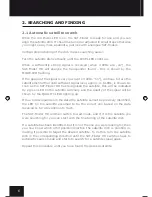
7
2.2 Manual search / satellite preselection
Manual search allows a preselection of satellites that are located close to each
other.
By pressing the left ″A” button once the currently active LED will move on one
step, thus selecting the next satellite. The satellites you can select are: 8°W,
7°W, 5°W and 4°W.
Turn the satellite dish vertically until the LEVEL LEDs light up.
When a sufficiently strong signal is received (when 3 LEDs are „on”), the
SAT-Finder HD will analyse the transponder found – that is shown by the
MODE-LED flashing.
If the quality of the signal is very low (up to 3 LEDs ″on”), continue to turn
the satellite dish further until sufficient signal quality, approx. 4-6 LEDs, is
shown. As soon as the SAT-Finder HD has recognised the satellite, this will
be indicated by a green LED on the satellite summary and the quality of the
signal will be shown by the QUALITY-LEDs lighting up.
If due to discrepancies in the data the satellite cannot be precisely identified,
the LED for the satellite assumed to be the correct one based on the data
received so far will continue to flash.
The SAT-Finder HD will then switch to wait mode, and if it is the satellite you
were searching for you can start with the fine tuning of the Satellite dish.
If you press the ″B” button the SF9002 will switch back to automatic search.
2.3 select the DiseqC position
The manual search has been supplemented by the transmission of the DiSEqC
switching sequences A, B, C, or D for the control of the monoblock LNBs.
Pressing the left button „A″ once puts the SF9002 into the manual search
mode in which the closely positioned 8°W, 7°W, 5°W and 4°W satellites can
be selected. This is followed by again pressing the button as needed to send
the DiSEqC signals for positions A, B, C, or D and the satellite search starts as
is described under „Automatic search″.
BDA_SF9002_GB.indd 7
18.03.14 09:27












